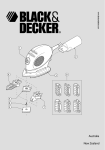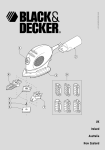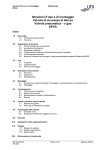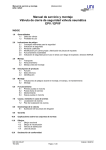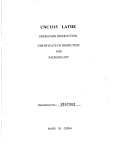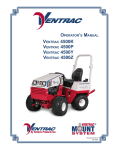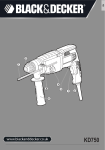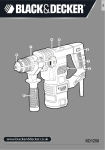Download Black & Decker KA161 Instruction manual
Transcript
KA160 KA160K KA161 KA161K English 2 (Original instructions) 6 A C B D E 3 F1 4 F2 H G I J 5 Intended use Your Black & Decker sander has been designed for sanding and polishing wood, metal, plastics and painted surfaces. This tool is intended for consumer use only. Safety instructions General power tool safety warnings @ Warning! Read all safety warnings and all instructions. Failure to follow the warnings and instructions listed below may result in electric shock, fire and/or serious injury. Save all warnings and instructions for future reference. The term "power tool" in all of the warnings listed below refers to your mains operated (corded) power tool or battery operated (cordless) power tool. 1. Work area safety a. Keep work area clean and well lit. Cluttered or dark areas invite accidents. b. Do not operate power tools in explosive atmospheres, such as in the presence of flammable liquids, gases or dust. Power tools create sparks which may ignite the dust or fumes. c. Keep children and bystanders away while operating a power tool. Distractions can cause you to lose control. 2. Electrical safety a. Power tool plugs must match the outlet. Never modify the plug in any way. Do not use any adapter plugs with earthed (grounded) power tools. Unmodified plugs and matching outlets will reduce risk of electric shock. b. Avoid body contact with earthed or grounded surfaces such as pipes, radiators, ranges and refrigerators. There is an increased risk of electric shock if your body is earthed or grounded. c. Do not expose power tools to rain or wet conditions. Water entering a power tool will increase the risk of electric shock. d. Do not abuse the cord. Never use the cord for carrying, pulling or unplugging the power tool. Keep cord away from heat, oil, sharp edges or moving parts. Damaged or entangled cords increase the risk of electric shock. e. When operating a power tool outdoors, use an extension cord suitable for outdoor use. Use of a cord suitable for outdoor use reduces the risk of electric shock. f. If operating a power tool in a damp location is unavoidable, use a residual current device (RCD) protected supply. Use of an RCD reduces the risk of electric shock. 6 3. Personal safety a. Stay alert, watch what you are doing and use common sense when operating a power tool. Do not use a power tool while you are tired or under the influence of drugs, alcohol or medication. A moment of inattention while operating power tools may result in serious personal injury. b. Use personal protective equipment. Always wear eye protection. Protective equipment such as dust mask, non-skid safety shoes, hard hat, or hearing protection used for appropriate conditions will reduce personal injuries. c. Prevent unintentional starting. Ensure the switch is in the off-position before connecting to power source and/or battery pack, picking up or carrying the tool. Carrying power tools with your finger on the switch or energising power tools that have the switch on invites accidents. d. Remove any adjusting key or wrench before turning the power tool on. A wrench or a key left attached to a rotating part of the power tool may result in personal injury. e. Do not overreach. Keep proper footing and balance at all times. This enables better control of the power tool in unexpected situations. f. Dress properly. Do not wear loose clothing or jewellery. Keep your hair, clothing and gloves away from moving parts. Loose clothes, jewellery or long hair can be caught in moving parts. g. If devices are provided for the connection of dust extraction and collection facilities, ensure these are connected and properly used. Use of dust collection can reduce dust-related hazards. 4. Power tool use and care a. Do not force the power tool. Use the correct power tool for your application. The correct power tool will do the job better and safer at the rate for which it was designed. b. Do not use the power tool if the switch does not turn it on and off. Any power tool that cannot be controlled with the switch is dangerous and must be repaired. c. Disconnect the plug from the power source and/or the battery pack from the power tool before making any adjustments, changing accessories, or storing power tools. Such preventive safety measures reduce the risk of starting the power tool accidentally. d. Store idle power tools out of the reach of children and do not allow persons unfamiliar with the power tool or these instructions to operate the power tool. Power tools are dangerous in the hands of untrained users. e. Maintain power tools. Check for misalignment or binding of moving parts, breakage of parts and any other condition that may affect the power tools operation. If damaged, have the power tool repaired before use. Many accidents are caused by poorly maintained power tools. f. Keep cutting tools sharp and clean. Properly maintained cutting tools with sharp cutting edges are less likely to bind and are easier to control. g. Use the power tool, accessories and tool bits etc., in accordance with these instructions, taking into account the working conditions and the work to be performed. Use of the power tool for operations different from those intended could result in a hazardous situation. 5. Service a. Have your power tool serviced by a qualified repair person using only identical replacement parts. This will ensure that the safety of the power tool is maintained. Additional power tool safety warnings @ Warning! Additional safety warnings for sanders Hold the power tool by insulated gripping surfaces, because the sanding belt / sanding base may contact its own cord. Cutting a "live" wire may make exposed metal parts of the power tool "live" and could give the operator an electric shock. u Use clamps or another practical way to secure and support the workpiece to a stable platform. Holding the work by hand or against your body leaves it unstable and may lead to loss of control. u Warning! Contact with or inhalation of dusts arising from sanding applications may endanger the health of the operator and possible bystanders. Wear a dust mask specifically designed for protection against dust and fumes and ensure that persons within or entering the work area are also protected. u Thoroughly remove all dust after sanding. u Take special care when sanding paint which is possibly lead based or when sanding some woods and metal which may produce toxic dust: - Do not let children or pregnant women enter the work area. - Do not eat, drink or smoke in the work area. - Dispose of dust particles and any other debris safely. u This tool is not intended for use by persons (including children) with reduced physical, sensory or mental capabilities, or lack of experience and knowledge, unless they have been given supervision or instruction concerning use of the appliance by a person responsible for their safety. Children should be supervised to ensure that they do not play with the appliance. u The intended use is described in this instruction manual. The use of any accessory or attachment or performance of any operation with this tool other than those recommended in this instruction manual may present a risk of personal injury and/or damage to property. u Safety of others This appliance is not intended for use by persons (including children) with reduced physical, sensory or mental capabilities, or lack of experience and knowledge, unless they have been given supervision or instruction concerning use of the appliance by a person responsible for their safety. u Children should be supervised to ensure that they do not play with the appliance. u Residual risks. Additional residual risks may arise when using the tool which may not be included in the enclosed safety warnings. These risks can arise from misuse, prolonged use etc. Even with the application of the relevant safety regulations and the implementation of safety devices, certain residual risks can not be avoided. These include: u Injuries caused by touching any rotating/moving parts. u Injuries caused when changing any parts, blades or accessories. u Injuries caused by prolonged use of a tool. When using any tool for prolonged periods ensure you take regular breaks. u Impairment of hearing. u Health hazards caused by breathing dust developed when using your tool (example:- working with wood, especially oak, beech and MDF.) Vibration The declared vibration emission values stated in the technical data and the declaration of conformity have been measured in accordance with a standard test method provided by EN 60745 and may be used for comparing one tool with another. The declared vibration emission value may also be used in a preliminary assessment of exposure. Warning! The vibration emission value during actual use of the power tool can differ from the declared value depending on the ways in which the tool is used. The vibration level may increase above the level stated. When assessing vibration exposure to determine safety measures required by 2002/44/EC to protect persons regularly using power tools in employment, an estimation of vibration exposure should consider, the actual conditions of use and the way the tool is used, including taking account of all parts of the operating cycle such as the times when the tool is switched off and when it is running idle in addition to the trigger time. 7 Labels on tool : The following pictograms are shown on the tool: Warning! To reduce the risk of injury, the user must read the instruction manual. Electrical safety # u This tool is double insulated; therefore no earth wire is required. Always check that the power supply corresponds to the voltage on the rating plate. If the supply cord is damaged, it must be replaced by the manufacturer or an authorised Black & Decker Service Centre in order to avoid a hazard. Features This tool includes some or all of the following features. 1. On/off switch 2. Dust extraction connector 3. Base 4. Tip holder 5. Sanding base tip 6. Finger attachment 7. Profile attachment 8. Screw 9. Sanding profiles In addition, this tool is supplied with some or all of the following accessories: AccessoryRecommended application and use u Coarse grit sandpaper Fast paint, varnish and rust removal u Medium grit sandpaper Paint, varnish and rust removal u Fine grit sandpaper Surface blending and finishing u Extra fine grit sandpaper Sanding between coats u Detail sanding tips Corners and hard to reach places u 1 OT polishing/stripping Polishing metals, stripping wool varnish and glass cleaning u Grey foam pad Applying and removing polish u Red non-woven pad Heavy scrubbing and rust removal u Grey abrasive paper Polishing plastics u Contour attachments Curves and profiles Assembly Warning! Before assembly, make sure that the tool is switched off and unplugged. 8 Fitting sanding sheets (fig. A & B) Detach the two diamond-shaped tips (10) from the sanding sheet (11). u Hold the tool with the sanding base facing upwards. u Place the sanding sheet (11) onto the sanding base, making sure that the holes in the sheet line up with the holes in the base. The diamond-shaped tip (10) can be reversed and replaced when worn. u When the front part of the tip is worn, detach it from the sheet, reverse it and press it onto the sanding base again. u When the whole tip is worn, remove it from the sanding base and fit a new tip. u The polishing foam and pads (14) can be fitted the same way as the sanding sheets. u Tip of the sanding base (fig. C) When the sanding base tip (5) or tip holder (4) is worn, it can be reversed or replaced. Spare parts are available from your Black & Decker dealer. u Remove the screw (8). u Reverse or replace the worn part. u Fit and tighten the screw. Finger attachment (fig. D) The finger attachment is used for fine detail sanding. u Remove the screw (8). u Remove the diamond-shaped tip holder (4) from the sanding base. u Fit the finger attachment (6) onto the sanding base. u Fit and tighten the screw. u Fit the appropiate sanding sheet (12) onto the finger attachment. Profile attachment (KA160K/KA161K only) (fig. E) The profile attachment is used for contour sanding. u Remove the screw (8). u Remove the diamond-shaped tip holder (4) from the sanding base. u Fit the profile attachment (7) onto the sanding base. u Fit and tighten the screw. Fitting and removing a sanding profile (fig. F1 & F2) u Choose the sanding profile most suitable for your application. u Place one end of the sanding profile (9) into the recess at the front end of the profile holder (7). u Push the other end of the sanding profile until it clicks into place. u To remove the sanding profile, push it forward and pull the rear end out of the profile holder (fig. F2). Fitting a sanding sheet onto a sanding profile (fig. G) u Align the sanding sheet (13) with the sanding profile (9). u Press the sanding sheet onto the sanding profile, making sure that the sanding sheet follows the shape of the profile. Use Warning! Do not cover the ventilation slots when using the tool. Hold the tool as shown in fig. H. Make sure that the sanding base is flat on the workpiece. Connecting a vacuum cleaner (fig. I) The tool has an adaptor to connect it to a vacuum cleaner when sanding wood. To connect the tool to a vacuum cleaner, proceed as follows: .$.$ Warning! Make sure that the tool is switched off and unplugged. u Fit the dust extraction connector (2) onto the adapter at the back of the tool. u Connect the hose of a suitable vacuum cleaner to the connector. Use Warning! Let the tool work at its own pace. Do not overload. Switching on and off (fig. J) Warning! Before connecting the tool to the power supply, make sure it is switched off. u To switch the tool on, press the part of the on/off switch (1) marked 'I'. u To switch the tool off, press the part of the on/off switch (1) marked '0'. Accessories The performance of your tool depends on the accessory used. Black & Decker and Piranha accessories are engineered to high quality standards and designed to enhance the performance of your tool. By using these accessories you will get the very best from your tool. Maintenance Your tool has been designed to operate over a long period of time with a minimum of maintenance. Continuous satisfactory operation depends upon proper tool care and regular cleaning. Warning! Before performing any maintenance, switch off and unplug the tool. u Regularly clean the ventilation slots in your tool using a soft brush or dry cloth. u Regularly clean the motor housing using a damp cloth. Do not use any abrasive or solvent-based cleaner. Mains plug replacement (U.K. & Ireland only) If a new mains plug needs to be fitted: u Safely dispose of the old plug. u Connect the brown lead to the live terminal in the new plug. u Connect the blue lead to the neutral terminal. Warning! No connection is to be made to the earth terminal. Follow the fitting instructions supplied with good quality plugs. Recommended fuse: 5 A. Protecting the environment Z Separate collection. This product must not be disposed of with normal household waste. Should you find one day that your Black & Decker product needs replacement, or if it is of no further use to you, do not dispose of it with household waste. Make this product available for separate collection. z Separate collection of used products and packaging allows materials to be recycled and used again. Re-use of recycled materials helps prevent environmental pollution and reduces the demand for raw materials. Local regulations may provide for separate collection of electrical products from the household, at municipal waste sites or by the retailer when you purchase a new product. Black & Decker provides a facility for the collection and recycling of Black & Decker products once they have reached the end of their working life. To take advantage of this service please return your product to any authorised repair agent who will collect them on our behalf. You can check the location of your nearest authorised repair agent by contacting your local Black & Decker office at the address indicated in this manual. Alternatively, a list of authorised Black & Decker repair agents and full details of our after-sales service and contacts are available on the Internet at: www.2helpU.com Technical data Input voltage Power input No-load speed Weight .$.$ Type 1 VAC 230 W 55 min-1 11,000 kg 0.8 9 Level of sound pressure according to EN 60745: Sound pressure (LpA) 66 dB(A), uncertainty (K) 3 dB(A) Sound power (LWA) 79 dB(A), uncertainty (K) 3 dB(A) Vibration total values (triax vector sum) according to EN 60745: Vibration emission value (ah) 5.6 m/s2, uncertainty (K) 1.5 m/s2 EC declaration of conformity % MACHINERY DIRECTIVE .$.$ Black & Decker declares that these products described under "technical data" are in compliance with: 2006/42/EC, EN 60745-1, EN 60745-2-4 For more information, please contact Black & Decker at the following address or refer to the back of the manual. _ The undersigned is responsible for compilation of the technical file and makes this declaration on behalf of Black & Decker. 10 Kevin Hewitt Vice-President Global Engineering Black & Decker Europe, 210 Bath Road, Slough, Berkshire, SL1 3YD United Kingdom 31/03/2010 Guarantee Black & Decker is confident of the quality of its products and offers an outstanding guarantee. This guarantee statement is in addition to and in no way prejudices your statutory rights. The guarantee is valid within the territories of the Member States of the European Union and the European Free Trade Area. If a Black & Decker product becomes defective due to faulty materials, workmanship or lack of conformity, within 24 months from the date of purchase, Black & Decker guarantees to replace defective parts, repair products subjected to fair wear and tear or replace such products to ensure minimum inconvenience to the customer unless: u The product has been used for trade, professional or hire purposes; u The product has been subjected to misuse or neglect; u The product has sustained damage through foreign objects, substances or accidents; u Repairs have been attempted by persons other than authorised repair agents or Black & Decker service staff. To claim on the guarantee, you will need to submit proof of purchase to the seller or an authorised repair agent. You can check the location of your nearest authorised repair agent by contacting your local Black & Decker office at the address indicated in this manual. Alternatively, a list of authorised Black & Decker repair agents and full details of our after-sales service and contacts are available on the Internet at: www.2helpU.com Please visit our website www.blackanddecker.co.uk to register your new Black & Decker product and to be kept up to date on new products and special offers. Further information on the Black & Decker brand and our range of products is available at www.blackanddecker.co.uk 11 12 13 14 ENGLISH Do not forget to register your product! www.blackanddecker.co.uk/productregistration Register your product online at www.blackanddecker.co.uk/productregistration or send your name, surname and product code to Black & Decker in your country. 15 Australia Black & Decker (Australia) Pty. Ltd. 20 Fletcher Road, Mooroolbark, Victoria, 3138 New Zealand Black & Decker 5 Te Apunga Place Mt Wellington Auckland 1060 United Kingdom Black & Decker 210 Bath Road Slough, Berkshire SL1 3YD 90563943 REV-0 Tel. 03-8720 5100 Fax 03-9727 5940 Tel. +64 9 259 1133 Fax +64 9 259 1122 Tel. 01753 511234 Fax 01753 551155 Helpline 01753 574277 03/2010

















